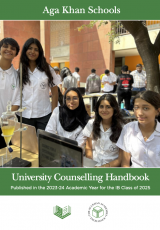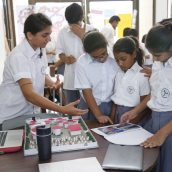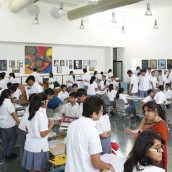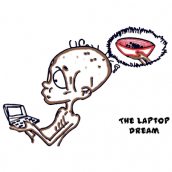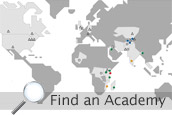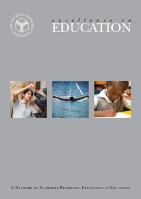Personal projects enable students to confront pressing social issues
The summer before she started grade 10, Insha Ladha, a grade 11 student at the Aga Khan Academy (AKA) in Hyderabad, met Sunita, a girl of her own age who lives in Rasoolpura, one of the largest informal settlements in Hyderabad. As Sunita talked about where she lived, Insha learned about the muddy roads and shoddy schools in Sunita’s neighbourhood and decided to see it for herself. When she paid a visit, she found that the conditions were even worse than she had imagined.
Insha talks about her work at the personal projects exhibition. As mud on unpaved streets weighed down Insha’s feet, she learned that the government only provided locals with drinking water every two to three days and that each toilet was shared by dozens of people. And she worried about the diseases caused by mosquitoes hovering around the area’s open drains.“The wish locals had to start a new life somewhere better was very hard because they didn’t have savings,” Insha explained. She couldn’t stop thinking about what she had seen and the people she had met, so she decided to make housing issues the topic of her grade 10 personal project. Her goal was to figure out how such a settlement could be designed in a sustainable way to help improve the quality of life of its residents.
Personal projects at the Academies
Rethinking urban housing design might seem like a tall task for a high school student, but Insha is not alone in pursuing such ambitious goals. Every year, grade 10 students at International Baccalaureate (IB) schools around the world undertake self-directed projects on a topic that entices them, whether that’s engineering or cooking. These projects, a core element of the IB Middle Years Programme, foster independent thinking and can count for as much as each student’s final grade in English or maths.
Personal projects exhibition at AKA Hyderabad “The personal project should revolve around a challenge that motivates and interests the student,” said Meenakshi Joshi, Middle Years Programme Coordinator at the Aga Khan Academy Hyderabad. “It’s a chance for students to take initiative, be creative and manage an entire project by themselves.”The Aga Khan Academies also throw in their own twist. In addition to meeting the IB requirements for the task, every student must show how his or her project links to one of the five Aga Khan Curricular Strands. These strands, which include Ethics, Pluralism, Cultures (with an emphasis on Muslim civilisations), Governance and Civil Society, and Economics for Development, guide the implementation of the entire IB curriculum at the Academies. By helping students to think about how they can relate to these issues, the personal projects make an important contribution to the Academies’ mission of nurturing “effective, ethical leaders” committed to improving their countries.
Students confront global issues
Using these guidelines, Academies' students have found creative ways to fuse their personal passions with social concerns. Bevertone Ochieng, a student in Mombasa who hopes to work as a diplomat or economic policymaker, created political cartoons that criticised problematic development policies in Kenya. Naaman Omar, who also studies in Mombasa, built a functioning solar panel. And Reena Kara, another Mombasa student, wrote a recipe book for rural Tanzanian families to help them figure out how to get maximum nutritional value from cheap meals.
Political cartoon by Bevertone “The emphasis within the Academies programme on using learning to take action and make a difference within our communities leads to many students choosing a development focus for their projects,” explained Alexandra Holland, Curriculum Development Manager at the Aga Khan Academies. “Many Middle Years Programme students might decide to write a recipe book, but Reena chose to focus hers on helping families who are living on limited incomes, rather than just focusing on food from around the world.”The projects often push students to think critically about pressing global issues and development challenges. For example, Insha surveyed local residents in Rasoolpura to learn about the challenges they faced, found an architect to teach her how to use a design software called AutoCAD, and read about approaches to urban planning to put together a report on how to improve Rasoolpura, complete with suggestions on how to plan local facilities.
Shreya Virani, another Hyderabad student, came up with the idea for her personal project after reading about the suffering of a 10-year-old girl who had gone through female genital mutilation. Concerned about violence against women, Shreya learned that forced labour, sexual slavery and human trafficking was a huge problem in India. She made it the focus of her personal project, which used artwork to raise awareness of the issue.
Students create projects for their communities
In addition to learning about and thinking of ways to tackle pressing social issues, many projects directly help local communities. For example, Karishma Bhagani, a recent graduate of the Aga Khan Academy Mombasa, designed a water filter that can be created from cheap and easily available components, allowing local families an affordable way to ensure their access to clean water.
Khushboo presents her project to the Aga Khan during a visit to the Academy. Similarly, Khushboo Khoja, a grade 12 student in Hyderabad, established a library in a local school for her personal project. “Literacy is not something that everyone has,” said Khushboo of her native Uganda. So, when she saw a need for more English-language resources in a government girls’ school in Hyderabad, where she had started volunteering in grade 9, Khushboo seized the opportunity.Even though they took English classes each week, the girls at the school had a limited grasp of English because the rest of their classes were taught in Telugu. Khushboo raised money to buy books to start an English language library, developed strategies to help the girls improve their reading levels and visited the school multiple times each week to read with the girls.
“There’s a lot that opens up to you when you read,” said Khushboo, who still volunteers at the school more than a year after completing the project. “Books are like another teacher. They provide a stream of knowledge.”
Students build skills and confidence
At the same time, projects are just as much about personal development as they are about the outside world. Students are assigned a faculty mentor that they can turn to for advice, but they are wholly responsible for planning and carrying out every aspect of the project, including finding funding and resources to make it happen.
Shreya presents her work to members of the Aga Khan's family. “I feel more confident about what I can do,” said Shreya when describing her project. She had to be resourceful to realise her goal of putting together an artwork series to raise awareness of gender issues related to modern-day slavery. In order to get funding for art supplies, she gathered old newspapers and sold them to a scrap dealer. In an effort to raise awareness of forced labour and to amass pieces for her exhibition, she ran an art contest for students in grades 7 through 9, asking them to learn and make piece of art about the issue. The winners were displayed alongside her own work once her project was complete.Students Form Career Goals
Personal projects also give students a chance to explore potential careers. For example, Kais Khetani, a grade 11 student in Hyderabad, had been fascinated by solar technology from a young age. For his project, he designed a prototype for a solar-powered car.
“I really liked the idea of how people can make an effort to reduce air pollution and also have an alternative for the expensive fuel,” he explained.
Kais had to overcome various hurdles, including testing different ways to harness the energy of the sun. He couldn’t find a way to effectively store solar energy in a battery, so he designed a toy-sized prototype with a solar panel roof. It only runs when directly under the sun, but Kais enjoyed the experience so much, he plans to become an engineer and build a real solar car that functions in all weather conditions and at night.
Hurdle by hurdle, personal projects help to build leaders like Kais that are committed to pursuing careers in which they can contribute to their society. For her part, Insha wasn’t sure about her career plans before starting her personal project. Now she aims to become an architect and work in a field where she can tackle urban challenges and housing inequality in India.
By Alia Dharssi
Newsletter readers please click here to return to the newsletter (browser version)
publications
